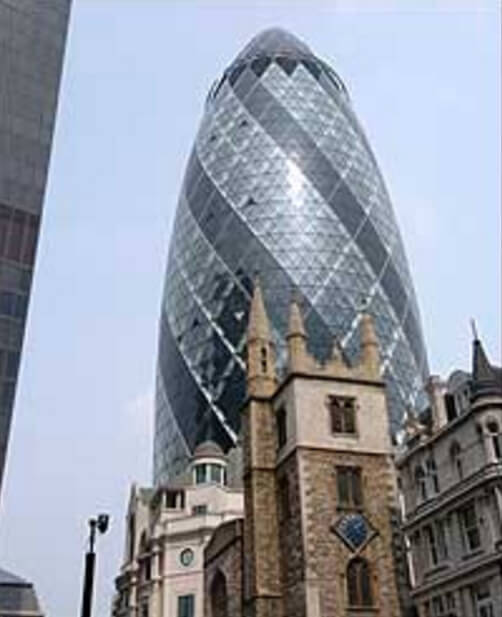One of London’s most recognisable landmarks, 30 St Mary Axe (affectionately called “the Gherkin”) was built under a JCT contract.
The 76,400 square metres project was commissioned by Swiss Re to replace the Baltic Exchange, which had been damaged by an IRA bomb in 1992. When planners realised the Exchange could not be recovered, they agreed to consider plans that were architecturally significant and unique. They sought an innovative, functional building that would not be too imposing on the traditionally narrow London streetscape. The Gherkin was ultimately approved because planners appreciated its state-of-the art design, and they did not think it would interfere with the city’s visual identity. Work on the Gherkin began in 2001, and the building opened in 2004.
The Gherkin is an innovative and efficient building, from its appearance to its design. The distinctive glass windows, which form an alternating pattern of dark and light coloured glass, serve a dual purpose. In addition to being aesthetically pleasing, the windows are double-glazed to provide insulation and reduce energy use. This feature alone has reduced the Gherkin’s energy use by up to 50 per cent. The Gherkin provides 76,400 square metres of office space, including a shopping arcade and a top-floor club with spectacular panoramic views of the city. The spiralling pattern of the windows is a result of the floor layout, which calls for each floor to be rotated five degrees relative to the floor beneath it.
The architects who designed the Gherkin, Foster and Partners, won the prestigious RIBA Stirling Prize for the best new building by an RIBA architect in 2004. It was the first time RIBA had ever made a unanimous decision.
Today the Gherkin is a prized feature of London’s architectural landscape, and an important addition to its cultural heritage.
Project team
Client: SwissRe
Architect: Foster and Partners
Main contractor: Skanska

